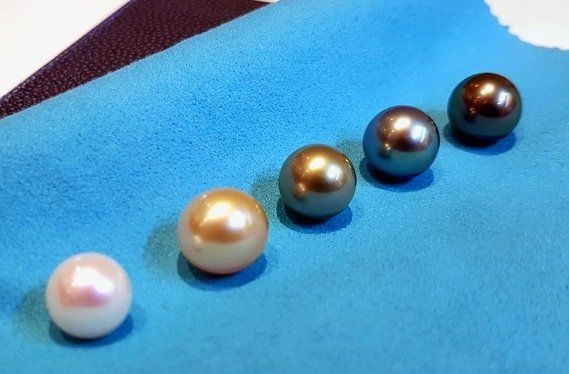The value of pearls is today a cardinal point on the discussion and knowledge of pearls. Indeed, no need to study worthless pearls because pearls are studied for their beauty. This beauty, although based on many more or less objective criteria, makes it possible to determine the value of a pearl. The beauty of a pearl, and therefore its value is determined by pearl specialists. These can be researchers or simply specialized in the study of and valuing precious pearls. Thus, each specialist is also specialized in the knowledge of a pearl and its characteristics. Knowledge of pearls is important because it helps to maintain continuity in the valuation of precious pearls.
In addition, the more expensive the pearls are valued, the more specialist checks there will be to see if the pearl is really of good quality and deserves its value. Finally, many specialists are licensed to practice this profession and to have the legitimacy to value a pearl. It is therefore necessary to check by buying a pearl whether the seller relies on recognized specialists or not. If not, absolutely avoid this seller. We only sell in our store pearls of very good quality and verified and valued by recognized specialists, so there is no need to worry.
Finally, it must be taken into account that pearls can lose value over time. Indeed, mother-of-pearl degrades more or less quickly. Although this factor is very random, experts take into account this possible degradation in the value of the pearl. In addition, the pearls are expertized after being cleaned. Their quality is at that time, after drying and cleaning to its maximum!
Here are the different criteria for classifying pearls. These criteria are the same for all pearls and are used just about anywhere in the world! The five criteria are the size of a pearl, its luster, its surface, its shape, and its color.

The size of a pearl
The size of a pearl corresponds to the diameter of the pearl. It's pretty simple to define because you just have to measure this diameter with a ruler or a sliding foot. There is no rule to tell which size goes what value because all pearls have a different categorization.
For example, Japanese pearls, Akoya pearls are smaller than the average of other pearls. An Akoya pearl 10 millimetres in diameter will be worth much more than a tahitian pearl 10 millimetres in diameter. Indeed, finding a pearl 10 millimeters in diameter knowing that it is a tahitian pearl is much more common.
Most of the time, the pearls range from 6 millimeters in diameter to 18 millimeters in diameter. Beyond that, pearls are much rarer regardless of their affiliation and characteristics. Finally, the pearls sometimes have a diameter difficult to measure because it is not necessarily round. It is therefore more difficult and sometimes impossible to determine a diameter at this pearl.
This leads us to talk about the shape of the pearls and the value of this criterion in determining the value of the pearls.
The shape of the pearls
This second criterion is also very important. Indeed, a bright pearl, very large with a beautiful color may not be worth anything if its shape is not harmonious. Usually the most expensive pearls are strictly rounded beads. For a pearl to be perfectly round, it must enter a variation interval of less than 2 millimetres from its original diameter. There are different categories of round pearls, A pearls, very round, B pearls with more variation in diameter, then C and D pearls.
In addition to round pearls, there are semi-round pearls. These pearls are only round on part of their shape. Their value can be exceptional if the shape is harmonious. However, as a general rule, these pearls are cheaper.
Finally, there are so-called baroque pearls. It is impossible to measure the diameter of these pearls because their shape is not at all round. Usually very common and not appreciated, they can sometimes be very expensive because their shape is no less harmonious.
So you have to be very careful when buying one or more pearls to check the quality of their shape beyond the diameter only.
The luster of a pearl
Especially with pearls, the chandelier represents the brilliance of the pearl or the orient. Obviously, this shine is measured once the stone has been cleaned and dried so that its reflection is at its maximum. To measure the brilliance of a pearl, experts use the quality of the reflection on the bead.
If the reflection is clear, the bead will have a high value. On the contrary, if the reflection is less clear, more blurred, then the pearl will see its value diminished. It is important to know that the brilliance of the pearls does not depend on other factors such as shape or size but especially on the characteristics of the oyster that created it.
The surface of a pearl
The surface of a pearl is also a very important criterion. Indeed, this is one of the criteria that can be seen with the naked eye for the worst pearls. The quality of the surface of a pearl represents the quantity and degree of imperfections present on a pearl.
All pearls have imperfections. This stage of expertise of the pearls allows to categorize the pearls according to this degree of imperfection on their surface. Some extremely rare pearls called AAA or A or Top GEMS are practically round, without imperfections.
The color of a pearl
Finally, the last criterion for classifying pearls is their colour. This criterion is different from the others because it is very much related to the other criteria. For example, some colors go better with baroque pearls, others with semi-round pearls. Some colors are more beautiful when there is little shine and others the opposite.
It is therefore impossible to set up a classification of the pearls according to their color. Finally, depending on their origin, the pearls will systematically have a certain color and almost determined reflections.
